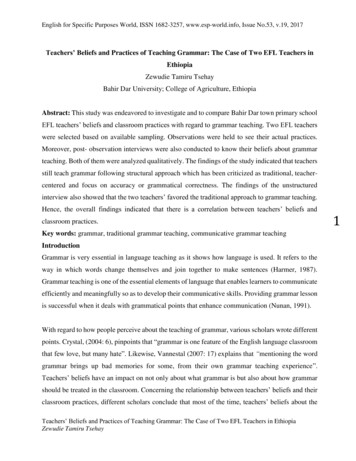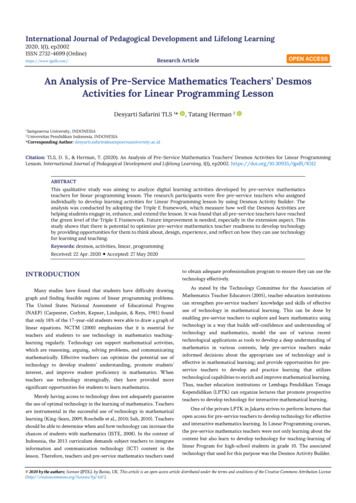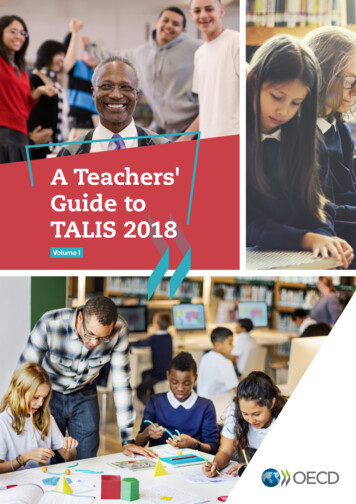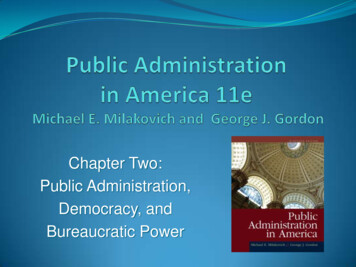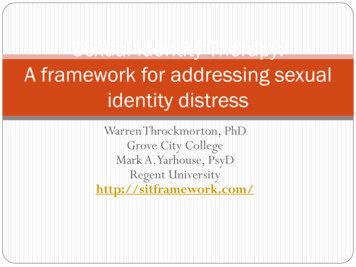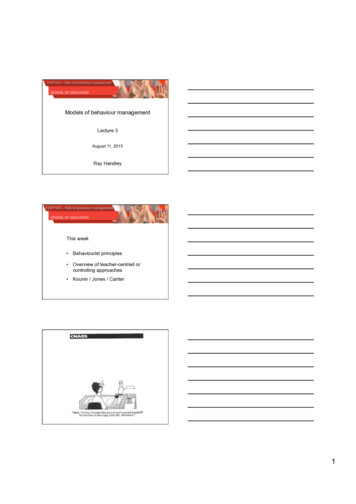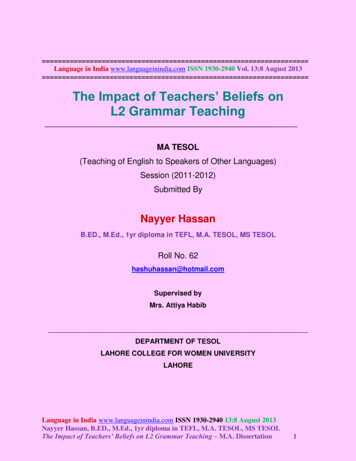
Transcription
Language in India www.languageinindia.com ISSN 1930-2940 Vol. 13:8 August 2013 The Impact of Teachers’ Beliefs onL2 Grammar TeachingMA TESOL(Teaching of English to Speakers of Other Languages)Session (2011-2012)Submitted ByNayyer HassanB.ED., M.Ed., 1yr diploma in TEFL, M.A. TESOL, MS TESOLRoll No. 62hashuhassan@hotmail.comSupervised byMrs. Attiya HabibDEPARTMENT OF TESOLLAHORE COLLEGE FOR WOMEN UNIVERSITYLAHORELanguage in India www.languageinindia.com ISSN 1930-2940 13:8 August 2013Nayyer Hassan, B.ED., M.Ed., 1yr diploma in TEFL, M.A. TESOL, MS TESOLThe Impact of Teachers’ Beliefs on L2 Grammar Teaching – M.A. Dissertation1
The Impact of Teachers’ Beliefs on L2 Grammar TeachingThesisSubmitted in Partial Fulfillmentof the requirements for the Degree ofMA TESOLAtLahore College for Women University, LahoreByNayyer HassanB.ED., M.Ed., 1yr diploma in TEFL, M.A. TESOL, MS TESOLRoll No: 62May, 2013Name: Mrs. Attiya HabibName: Mrs. Seema SohailSupervisorCourse CoordinatorDepartment of TESOLDepartment of TESOLLanguage in India www.languageinindia.com ISSN 1930-2940 13:8 August 2013Nayyer Hassan, B.ED., M.Ed., 1yr diploma in TEFL, M.A. TESOL, MS TESOLThe Impact of Teachers’ Beliefs on L2 Grammar Teaching – M.A. Dissertation2
DedicationI would like to dedicate this research to my father, my-in-law father, my mother-in-law,my husband and my sons Junaid Hassan and Hadi Hassan who had been a greatsource of motivation throughout my research, and it would not have been possible toaccomplish this study, if their cooperation and support had not been with me.Language in India www.languageinindia.com ISSN 1930-2940 13:8 August 2013Nayyer Hassan, B.ED., M.Ed., 1yr diploma in TEFL, M.A. TESOL, MS TESOLThe Impact of Teachers’ Beliefs on L2 Grammar Teaching – M.A. Dissertation3
AcknowledgmentI’m extremely grateful to the Head of the TESOL department Mrs Seema Sohail foroffering an opportunity to conduct such kind of a research, which otherwise I wouldnever have done in my life. I’m thankful to my supervisor Mrs. Attyia who had been agreat helping hand from the very beginning till the end of my study. I would like to thankthe senior teacher of Crescent Model School Miss Shaheena who always gave aspecial priority to my research work. I’m thankful to all the participants of research,specially the faculty of Adbistan-e-Sophia and my colleagues Mrs Rehana, MrsShabana, Mrs Sameera, Mrs Riffat and Mrs Kausar who spent their precious time asresearch participants.Language in India www.languageinindia.com ISSN 1930-2940 13:8 August 2013Nayyer Hassan, B.ED., M.Ed., 1yr diploma in TEFL, M.A. TESOL, MS TESOLThe Impact of Teachers’ Beliefs on L2 Grammar Teaching – M.A. Dissertation4
List of piciv.List of Tablesv.AbstractChapter 1- INTRODUCTION10-131.1 Statement of Problem1.2 Operational definition of teachers’ beliefs1.3. Justification of the study1.4 Significance of the study1.5 Aim and Objectives1.6 Research Questions1.7 Delimitations of the study1.8 Procedure of the dissertationChapter 2- Literature Review14-292.1 Historical Background of Grammar Teaching2.1.1 Importance of Grammar in History2.2 Belief about teaching grammar and its influence2.2.1 Behaviourist and Constructivist Approach2.2.2 Communicative approach vs Structural Approach2.2.3 Integrative approach to grammar2.2.4 Deductive and Inductive Method2.2.5 Conscious vs. unconscious language learning2.2.6 Effectiveness of Task-Based Learning2.2.7 Functional Approach2.2.8 Eclectic Approach2.3 Advantages of involving learners2.4 Using games to teach grammarLanguage in India www.languageinindia.com ISSN 1930-2940 13:8 August 2013Nayyer Hassan, B.ED., M.Ed., 1yr diploma in TEFL, M.A. TESOL, MS TESOLThe Impact of Teachers’ Beliefs on L2 Grammar Teaching – M.A. Dissertation5
2.5 Teaching Grammar through Writing2.6 Dilemma of Learning Grammar2.7 Relationship between Beliefs and Classroom Practices2.8 Ineffective Grammar Teaching2.9 Place of English Grammar in Asia2.9.1Students of South Asia2.9.2 Suggestions for improving Grammar teaching in Asia2.10 Status of English Grammar Teaching in PakistanChapter 3- Procedure of the Study30-333.1 Population3.2 Sample3.3 Instrument of the Study3.3.1 Questionnaire3.3.2 Interview Data3.3.3 Classroom Observation Data3.4 Data collection and analysisChapter 4- Analysis and interpretation of data34-554.1 Analysis and interpretation of data4.2 Quantitative Data4.2.1 Learning second language without grammar instruction4.2.2 Order of learning different grammatical structures4.2.3 Teaching grammar to learners of all levels4.2.4 Working out grammar rules from examples4.2.5 Familiarity with the correct grammatical terminology4.2.6 Importance of giving feedback to the students4.2.7 Importance of feedback for written exercise or test4.2.8 Language course should mainly focus on teachingand practicing grammar4.2.9 Identification of grammatical errors in students’ written workLanguage in India www.languageinindia.com ISSN 1930-2940 13:8 August 2013Nayyer Hassan, B.ED., M.Ed., 1yr diploma in TEFL, M.A. TESOL, MS TESOLThe Impact of Teachers’ Beliefs on L2 Grammar Teaching – M.A. Dissertation6
4.2.10 Explanation of how a particular structure works4.3 Qualitative Data4.3.1 Meaning of grammar4.3.2 Role of grammar in language teaching and learning4.3.3 Importance of teaching grammar4.3.4 Difficulties in teaching grammar4.3.5 Grammar activities used by teachers4.3.6 Suggestions about teaching grammar4.4 Analysis of Class Observations4.5 Analysis of Interviews4.5.1 Language Learning Background4.5.2 Influence of language learning experiences on teaching4.5.3 Beliefs about Learning L2 Grammar4.5.4 Reported Beliefs about Teaching Practices4.6 Discussion4.6.1 Various definitions of grammar4.6.2 Role and importance of Grammar4.6.3 Error Correction4.6.4 Beliefs about Grammar teaching and classroom practices4.6.5 Influence of Language experiences on teaching practices4.6.6 Factors behind Teachers Beliefs4.6.7 Correlation between teachers’ beliefs and their actualclassroom practicesChapter 5- Summary / Findings and Recommendations56-595.1 Summary5.2 Findings5.3 Conclusions5.4 RecommendationsLanguage in India www.languageinindia.com ISSN 1930-2940 13:8 August 2013Nayyer Hassan, B.ED., M.Ed., 1yr diploma in TEFL, M.A. TESOL, MS TESOLThe Impact of Teachers’ Beliefs on L2 Grammar Teaching – M.A. Dissertation7
References60-64Appendices65-87Appendix A: Survey QuestionnaireAppendix B: Interview QuestionnaireAppendix C: Interviews (Transcription)List of TablesTable 1: Descriptive statistics for importance of grammarTable 2: Descriptive statistics of feedback and error correctionTable 3: Descriptive statistics for learning L2 grammarLanguage in India www.languageinindia.com ISSN 1930-2940 13:8 August 2013Nayyer Hassan, B.ED., M.Ed., 1yr diploma in TEFL, M.A. TESOL, MS TESOLThe Impact of Teachers’ Beliefs on L2 Grammar Teaching – M.A. Dissertation8
AbstractThe following research studies the correlation between teachers’ beliefs about teachinggrammar and their actual classroom practices. There was a need of such kind of studyin Pakistani context in order to make teachers realize the importance of knowing one’steaching beliefs before moving to changing them. This research is a mixture ofqualitative and quantitative research. Survey questionnaire, interviews and classobservations were used for data collection. Data was collected from three semigovernment schools where as five teachers were conveniently selected for classobservations and interviews. The data was analyzed and interpreted to get the finalresults. It is concluded that there is a deep woven correlation between teachers’ beliefsabout teaching English grammar and their classroom practices of teaching grammar. Itis recommended that teachers should know their existing teaching beliefs because it isthe need of the hour to improve our educational standards by making positive changesin the teaching of grammar.Language in India www.languageinindia.com ISSN 1930-2940 13:8 August 2013Nayyer Hassan, B.ED., M.Ed., 1yr diploma in TEFL, M.A. TESOL, MS TESOLThe Impact of Teachers’ Beliefs on L2 Grammar Teaching – M.A. Dissertation9
Chapter 1IntroductionTeaching is mainly an outcome of a teacher’s perception. Philosophy of teachingrevolves around one’s understanding about how students learn, what type ofinstructions are the best suitable for deep and concrete learning, what actions shouldbe taken to enact such instruction. It also defines ones teaching and learning goalsand the specific areas in which a teacher wants herself /himself to improve his/herabilities. As Richards(1996) reflected in his book’ work on teachers’ maxims’ thatthese maxims are a set of rational principles that function as ‘’rules for bestbehavior”(p.286). All these maxims cover all different aspects of teaching , includingplanning, encouraging and motivating learners, maintaining order and discipline inthe classroom, empowering learners, as well as maxims related to accuracy,conform and efficiency.The structure of a teacher’s belief is quite simple or uniform. It seems to beinterconnected and muli-faced. Teachers’ beliefs deeply influence both behaviourand perception. Pajares (1992,p.324 as cited in Mohamad2006) claimed that theirfiltering effect “ultimately screens, redefines, distorts, or reshapes subsequentthinking and information process.”There is a crucial need to explore the teachers’ perceptions about teaching Englishgrammar and their actual classroom practices in private schools of Pakistan. Prabhu(1990 as cited in Mohammad 2006) too refers to the danger of reutilization ormechanical teaching: in order to improve educational standards, teachingphilosophies of teachers is the most important thing to be focused. Whatever ateacher does in her classroom is an outcome of her educational beliefs, whether sheis aware of her teaching philosophy or not. William and Burden (1994) state thatteachers’ beliefs play a vital role in the teaching learning process that is whyteachers must know their own beliefs, philosophies or theories. They stress thatteachers must record their personal reflection continuously because by becomingLanguage in India www.languageinindia.com ISSN 1930-2940 13:8 August 2013Nayyer HassanThe Impact of Teachers’ Beliefs on L2 Grammar Teaching10
aware of their beliefs that they come to understand their own implicit theories and theways these theories influence their professional practice. Teachers’ beliefs can betransformed by experience, knowledge, professional development and making themaware of their teaching approaches. According to Fisher (2007) a teacher mustunderstand his/her teaching philosophies so that he/she can work on furtherimprovement. Most of the researches have focused only the self-reported beliefsthrough interviews and questionnaires, whereas a few have investigated whetherthese beliefs are practiced in classroom or not. No doubt, there is an essential needto find out whether there is a correlation between teacher’s beliefs about teachingEnglish grammar and their actual classroom practices.1.1Statement of ProblemCorrelation between teachers’ perceptions about teaching English grammar andtheir classroom practices.1.2 Operational definition of teachers’ beliefBelief refers to a teacher’s personal perception about teaching English grammar.The entire teaching learning process revolves around their own particular beliefsabout English grammar teaching.1.3 Justification of the studyIt has been observed in Pakistani context that different schools vary in their Englishlanguage teaching objectives, goals, and assessment criteria of students learningand teachers’ teaching. However teachers too on the other hand take grammaticalconcepts differently and use different teaching methodologies in their classes. Sothese differences in teachers’ beliefs are the main source of motivation to conductthis study which explores teachers’ beliefs about grammar and their classroompractices. It further finds out the correlation between teacher’s beliefs and theirclassroom practices.Language in India www.languageinindia.com ISSN 1930-2940 13:8 August 2013Nayyer HassanThe Impact of Teachers’ Beliefs on L2 Grammar Teaching11
1.4 Significance of the studyThis study will motivate English teachers to know about their beliefs about teachinggrammar and their influence on their instructional practices. It will in fact help to raiseeducational standard of English language teaching by enlightening the importance ofknowing ones teaching belief and making an effort for improvement. Teachers,teacher trainers, principals, students and the whole educational system would benefitfrom this study because it studies the influence of teachers’ beliefs on theirclassroom practices and encourages teachers to change their present beliefs inorder to improve their instructional practices.1.5 Aims and ObjectivesThe aim of this research is to explore the interconnection between teachers’ beliefsand their instructional practices along with the factors that underpin these beliefs.In particular, this investigation seeks to answer the following research questions:1. a) To identify the beliefs of semi-government primary school teachers ofLahore about English grammar, its acquisition and methods of instruction.2. a) To explore classroom practices of primary English teachers ofsemi-government schools of Lahore.b) To find out the correlation between teachers’ beliefs about teachinggrammar and their instructional practicesc) To unfold the underpinning factors which constrain these teachers whiletranslating their beliefs into practice.1.6 Research Questions What kinds of beliefs do English teachers have about teaching grammar? What are the factors which underpin these beliefs?Language in India www.languageinindia.com ISSN 1930-2940 13:8 August 2013Nayyer HassanThe Impact of Teachers’ Beliefs on L2 Grammar Teaching12
How do teachers teach English grammar in their classes? What is the correlation between teachers’ beliefs about teaching grammar andtheir class room practices?1.7 Delimitations of the studyEighty English teachers of semi-government primary schools of Lahore wereselected to get data from survey questionnaire. Five teachers were convenientlyselected for class observations and interviews.1.8 Procedure of the DissertationThe thesis is organized into five chapters. First chapter is an introduction whichprovides the outline of the research, its purpose and the context of the study. Thenext one reviews the literature relevant to English grammar teaching, its history,different approaches to grammar, interplay between beliefs and instructionalpractices etc. The third chapter explains research methodology, sample andinstruments used for research accomplishment. Chapter four is about analysis,interpretation and discussion of the collected data. A concise summary of research,its findings, and conclusion has been discussed in the fifth chapter.Language in India www.languageinindia.com ISSN 1930-2940 13:8 August 2013Nayyer HassanThe Impact of Teachers’ Beliefs on L2 Grammar Teaching13
Chapter 2Literature Review2.1 Historical Background of Grammar TeachingImportance of grammar teaching in second language learning is well known. Longago from the fifteenth century there had been a long debate on the problems ofteaching grammar effectively. For centuries, language has been synonymous withlanguage teaching then the role of the grammar declined with the introduction ofcommunicative language teaching (Thompson 1996). At the beginning of 1970 theinterest of ‘real language’ teaching emerged and more interest was taken in socialand cultural teaching of language. Consequently, it proved to be a shift from audiolingual and grammar translation methods to the exploration to communicativeteaching of language. Hence integrative tasks were focused instead of discretestructures.2.1.1 Importance of Grammar in HistoryTeaching grammar has always been a matter of controversy especially in secondlanguage acquisition as Thornbury (1999 p.14 as cited in Neupane 2009 ) says” infact no other issue has preoccupied theorists and practitioners as the grammardebate, and the history of language teaching is essentially the history of claims andcounter claims for and against the teaching of grammar” .2.2 Belief about teaching grammar and its influenceThe main difference in grammar teaching methods is due to teachers’ different viewsabout the role of grammar. According to the historic overview of the role of grammarBygate et al. (1994 as cited in Neupane 2009) says that in the light of the centuriesold tradition of language learning dominated by Latin and Greek, the study oflanguage is mainly the study of its grammar. In old times grammar has the centralLanguage in India www.languageinindia.com ISSN 1930-2940 13:8 August 2013Nayyer HassanThe Impact of Teachers’ Beliefs on L2 Grammar Teaching14
role in structural linguistics. According to Wilkins (1972 as cited in Bygate et al.1994as cited in Neupane 2009 ) the aim of a language teacher is to enable the people tolearn it .Some people have a view that grammar teaching is not essential because itdoesn’t facilitate second language acquisition. Krashen and Terrell (1983 p.144 ascited in Neupane 2009) are in favor of this idea when they say, “we prefer to avoidoral grammar instruction in classrooms imply because they take time away fromacquisition activities. Whereas others own the view that it is essential to teachgrammar. Ur (1996 as cited in Gnawali, et al.2061 as cited in Neupane 2009 ) hassimilar views when he shows his doubts about gaining communication competencyto develop accuracy in learners when she says that the ability to icientlythroughpureclasscommunication practice – not at least in the framework of formal study course.Thornbury (1999 p.16 as cited in Neupane2009) agrees with Ur and suggests thatlearning L2 without learning grammar is “at the risk of fossilizing sooner than thosewho receive”.2.2.1 Behaviourist and Constructivist ApproachThe beliefs of language teachers about the process of teaching and learning play avital role in their classroom practices and in their professional growth. Two maintypes of approached are there which occupy teachers’ belief .One approach isbehaviourist approach which is based on the stimuli present in the environmentwhereas the second one is constructivist approach which claims that learning takesplace as a result of actively constructing meanings from the environment (Hoover1996 as cited in Mohammad 2006). As Harste and Burke (1977 as cited in IrenaKuzborska research on Links between teachers’ beliefs and practices and researchon reading April 2011, Volume 23) states that teachers make their decisions abouttheir classroom teaching according to their theoretical beliefs about the wholeprocess of teaching and learning. They hold their own assumptions about teachingand learning according to their own particular approach, (Richards and Rodgers2001 cited in Irena 2001). Irena in her research on Links between teachers’ beliefsand practices and research on reading (April 2011, Volume 23) conducted inLithuania proved that the teachers’ classroom practices were guided by their beliefsLanguage in India www.languageinindia.com ISSN 1930-2940 13:8 August 2013Nayyer HassanThe Impact of Teachers’ Beliefs on L2 Grammar Teaching15
and there was a very strong relationship between teachers’ theoretical beliefs andtheir classroom practices.2.2.2 Communicative approach vs. Structural ApproachSavvidou (2004) also believes that communication can’t take place without structureor grammar.Ellis,1997 as cited in Sysoyev 1999) in her review of research startingfrom 1970 says that communicative teaching of English was thought to be ignoringgrammar for the sake of focusing on meaning only structure. If we comparecommunicative (as referred to meaning-based) to form based (as referred to asstructure-based) approaches in English language teaching that communicativeteaching helps students to communicate properly but it doesn’t guarantee that thestudent will speak linguistically correct sentences. Whereas the form basedapproach focuses on grammatical structures and linguistics which enables theperson to speak accurate grammatical sentences. After this movement they startedgiving more priority to fluency rather than accuracy. It gave an ease to non-nativeteachers of English who felt difficulty in grammar teaching and for the nativeteachers as it was a good reason for their incompetence in grammar of their ownlanguage (Swan, 2006).But the grammar soon came into being by the half of 1980s.2.2.3 Integrative approach to grammarEllis (2003 as cited in Mohammad 2006), among others argues that in order toachieve the objective of communicative competence, grammar and communicationshould have to be integrated. An integrated model is an approach in which someteaching strategies are used in stylistic analysis which not only explores texts,literary and nonliterary from the perspective of style and its relationship to contentand form. This approach involves the systematic and detailed analysis of the stylisticfeatures of a text- vocabulary, structure, register, etc., in order to find out not justwhat a text means but also how it comes to mean what it does (Short 1996 as citedin Savvidou 2004).2.2.4 Deductive and Inductive MethodLanguage in India www.languageinindia.com ISSN 1930-2940 13:8 August 2013Nayyer HassanThe Impact of Teachers’ Beliefs on L2 Grammar Teaching16
Many theoretical proposals are there which try to incorporate such instruction into L2curriculum. Among these are the distinctions between deductive and inductiveapproaches (Thornbury1999). Deductive approaches start with teachers explicitlystating grammar rules whereas the inductive approach doesn’t start with the explicitpresentation of rules. The students are made to discover the structures or may beasked to drive the rules that govern it. Deductive grammar instruction is related torules driven instruction whereas inductive grammar deals with discovering the rulesthrough consciousness raising (Rutherford 1987 as cited in Mohammad 2006).2.2.5 Conscious vs. unconscious language learningKrashen (1981 as cited in Mohammad 2006) distinguishes between consciouslearning and unconscious acquisition of language, he says that language should beacquired through natural exposure, and should not be learned through formalinstruction. In the traditional approach, where a language is consciously learned,attention is focused on the language in its written form and the objective is for thestudent to understand the structure and rules of the language through the applicationof intellectual and logical deductive reasoning (Krashen 1982 as cited inVasilopoulos 2008).Opposite to the previous approach the indirect approach of CLTis mainly based” on the learner’s ability to interactively negotiate meaning, with newlinguistic forms being acquired incidentally during this process. Therefore, applyingthese principles in the classroom requires new classroom techniques and activities.Additionally, these principles call for new roles for teachers and learners. Instead ofrelying on activities that demand accuracy, repetition and the memorization ofsentences and grammatical patterns, these new activities require learners tonegotiate meaning and to interact meaningfully in the English language.2.2.6 Effectiveness of Task-Based LearningGill (2012) in his article task-based learning, from University of Central Lancashireshares his anecdotes from his experiences of second language learning. He makesa contrast between conventional and task-based method of teaching and learningLanguage in India www.languageinindia.com ISSN 1930-2940 13:8 August 2013Nayyer HassanThe Impact of Teachers’ Beliefs on L2 Grammar Teaching17
while studying abroad. According to him task-based method gave him a “click whichhe needed to reach fluency. This click is when everything comes together: thegrammar starts to make sense.” Gill (2012) further maintains that this click variesfrom person to person as for some people it comes within a month whereas otherscould take long time. Task –based language learning method makes the secondlanguage learning process much easier than learning through old conventionalmethods. Learner starts accepting the major differences between the first and thesecond language and the learners mind begins to process the language in a muchconfusing way which is according to Gill (2012 ) is the first step to fluency. So themore powerful the L2 speaking atmosphere is, the easier will be the process of l2language development. Gill (2012) also described his own good experience oflearning Japanese as L2 through repetitive structure and independent composition.But he emphasized that the best way to learn a second language is by living in thatcountry in which it is spoken because fluency is rapidly attained “through constantconversation”. He preferred using repetition method when L2 is not spokeneverywhere in the society or where there is a non-native atmosphere. Role play andgiving directions to someone is also a kind of task based learning when studentslearn a language by using it a certain atmosphere or by doing something. Taskbased learning is also described as learning by doing. He concluded through hispersonal L2 learning experience, “I think task–based learning is more effective thanpurely using books.” Gill (2012)Only a few studies have been found which were conducted on the comparison ofcommunicative to form based approaches. According to the results of theexperimental study in communicative language teaching conducted by Prabhu (citedby Beretta &Davies 1985 as cited in Sysoyev1999) that experimental group, whichreceived meaning based instruction, did well on the meaning based test, but theyshowed low result on the discrete-point test. On the other hand the control groupwhich had received structural instructions, performed better on grammar structuretasks, rather than on the global and the integrative tests. The results were clear thatthe students’ performance was better on the tasks they were trained for.2.2.7 Functional ApproachLanguage in India www.languageinindia.com ISSN 1930-2940 13:8 August 2013Nayyer HassanThe Impact of Teachers’ Beliefs on L2 Grammar Teaching18
The primary focus of our teaching should be the teaching of meaning rather thanform (Skehan, 1998; Willis & Willis, 2007 as cited in Adamson 2010). Nonetheless,due attention must be paid to form for learning to occur: “ if students are to actuallyacquire a second language by ‘going for meaning’, then have to be engaging, insome way ,in some sort of form function analysis “(Swain,1988,p.72 as cited inAdamson 2010)To be elaborated: A number of research studies have reported that learners needample opportunities for communication use so that they can integrate separatestructures into given concepts for expressing meanings. Spada & Light Brown (1993)hold that thinking skills operate effectively when students voice their analysis andtake part in the learning process occurring in the classroom. Methodologists alsoargue that learners in the classroom should experience creative reflections throughwhich the teacher probes their understanding to elicit answers for the questions heor she poses. In this way, students can lay the foundations for their internalrepresentation of the target language, which can allow effective learning to functionproperly (Pica, 1994).2.2.8 Eclectic ApproachThe ideal approach which is now considered as the most effective and successful inthe teaching of writing is the eclectic approach. The eclectic or process genreapproach combines process theories with genre knowledge. This concept not onlydraws ideas from genre approach, such as knowledge of context, the purpose ofwriting, and certain text features but retains part of process philosophy such aswriting skill development and learner response (Badger & White, 2000 cited in SouthAsian Studies A Research Journal of South Asian Studies) Vol. 27, No. 1, JanuaryJune 2012, pp.183-194). It is stated that eclectic approach provides the learner withopportunities for developing their individual creativity as well as helping them fullyunderstand the features of target genres (Y. Kim, & J. Kim, 2005 cited in A ResearchJournal of South Asian Studies Vol. 27, No. 1, January-June 2012, pp.183-194 ).Language in India www.languageinindia.com ISSN 1930-2940 13:8 August 2013Nayyer HassanThe Impact of Teachers’ Beliefs on L2 Grammar Teaching19
2.3 Advantages of involving learnersMany researchers such as Chaudron (1988) further documented the benefits ofinvolving students in the learning process. These investigators found that studentstaught by teachers who actively involved them in lessons achieved at higher ratesthan those in traditional classes. Inductive and deductive models offer this chance tolearners because these two models foster a cooperative atmosphere amongstudents. According to Celce-Murcia et al (1997), the communicative classroomprovides a better environment for second language learning than classroomsdominated by formal instruction. He concluded but the above conclusions do notnegate the fact that both techniques, inductive and deductive, are worthconsideration by all language teachers. Effective use of these strategies wouldenable teachers to experiment with their teaching methods in order to seek improvedperformance by their student.2.4 Using games to teach grammarMany students and linguists have the point that grammar should be included incurriculum not in the sense of traditional ways of grammar teaching Hadfield (1990as cited in
The Impact of Teachers’ Beliefs on L2 Grammar Teaching – M.A. Dissertation 9 Abstract The following research studies the correlation between teachers’ beliefs about teaching grammar and their actual cl
